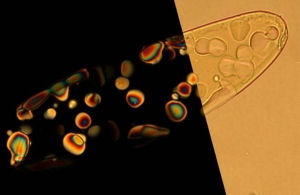By directing the evolution of silicateins, the proteins responsible for the formation of silica skeletons in marine sponges, scientists at the University of California Santa Barbara have synthesized novel semiconducting materials.
“In the realm of human technologies it would be a new method, but it’s an ancient approach in nature,” said Lukmaan Bawazer, the first author of a paper detailing the work in the Proceedings of the National Academy of Sciences.
Bawazer said that silicateins, which are genetically encoded, serve as templates for the silica skeletons and control their mineralization, thus participating in similar types of processes by which animal and human bones are formed. Silica is the primary material in most commercially manufactured semiconductors.
In the study, polystyrene microbeads coated with specific silicateins were put through a mineralization reaction by incubating the beads in a water-in-oil emulsion that contained chemical precursors for mineralization: metals of either silicon or titanium dissolved in the oil or water phase of the emulsion. As the silicateins reacted with the dissolved metals, they precipitated them, integrating the metals into the resulting structure and forming nanoparticles of silicon dioxide or titanium dioxide.
“This genetic population was exposed to two environmental pressures that shaped the selected minerals: the silicateins needed to make [mineralize] materials directly on the surface of the beads, and then the mineral structures needed to be amenable to physical disruption to expose the encoding genes,” explained Bawazer. “The beads that exhibited mineralization were sorted from the ones that didn’t, and then fractured to release the genetic information they contained, which could either be studied, or evolved further.”
Importantly, silicateins are enzymes with relatively long amino acid chains that can fold into precise shapes, so there is the potential for more functionality than would be possible using shorter biopolymers or more traditional synthetic approaches.
Bawazer believes the process could potentially work with a variety of metals, evolving different types of materials. “By changing the laboratory-controlled environments in which directed evolution occurs, it might be possible to evolve materials with specific capacities, like high performance in an evolved solar cell, for example. I’d like to take it a step further and evolve material performance in a functional device,” he said.
Related:
Discuss this article in our forum
Battery built from GM viruses
Heredity and evolution seen in synthetic DNA
Synthetic genome successfully transplanted into cell
Electronic components made from human blood


















Comments are closed.